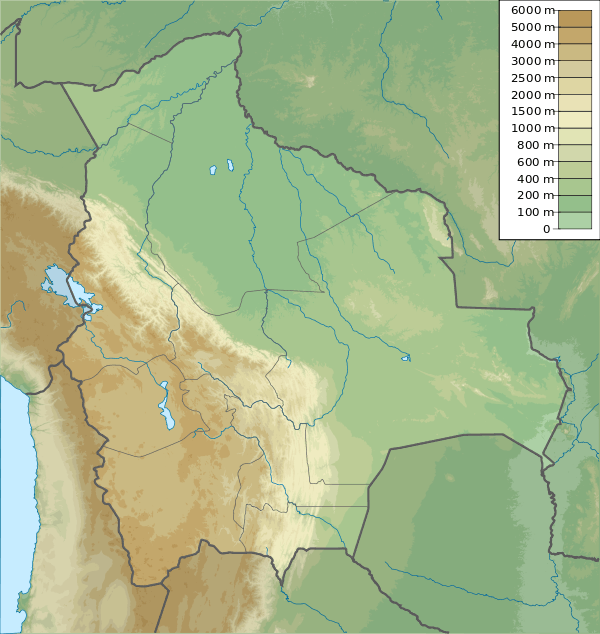Cerro Cañapa
| Cerro Cañapa | |
|---|---|
 Cañapa North Face | |
| Highest point | |
| Elevation | 5,882 m (19,298 ft) [1] |
| Prominence | 1,595 m (5,233 ft) [2] |
| Listing | Ultra |
| Coordinates | 21°27′S 68°04′W / 21.450°S 68.067°WCoordinates: 21°27′S 68°04′W / 21.450°S 68.067°W |
| Geography | |
 Cerro Cañapa Bolivia | |
| Location | Potosí Department, Bolivia |
Cerro Cañapa is an elongated mountain in Bolivia close to the border with Chile. Note that the international border in this area is a straight line that runs from Cerro Araral to Ollagüe, leaving Cerro Cañapa completely in Bolivian territory.
The mountain forms an enormous backdrop to the colorful lakes Cañapa and Hedionda.
The mountain is constructed from andesite and dacite.[3] Volcanism of Canapa was influenced by local northwest-striking normal fault zones which also affected the Luxsar and Toconce volcanoes.[4] The range is partially underpinned by modern ignimbrites. Canapa has deposits left by solfataras.[5] The volcanic range is 50–100 kilometres (31–62 mi) long and may have originated from deep seated basement lineaments.[6] Volcanism is Pliocene-Pleistocene in age.[3]
See also
References
- ↑ Topographic map Cerro Araral, Chile; Bolivia SF-19-7, Joint Operations Graphic 1:250,000, U.S. National Imagery and Mapping Agency
- ↑ "Bolivia Ultra-Prominences". Peaklist.org. Note: Prominence value from this source is based on an elevation of 5,900 m. Retrieved 2013-02-25.
- 1 2 "Cañapa". Global Volcanism Program. Smithsonian Institution.
- ↑ Tibaldi, A.; Corazzato, C.; Rovida, A. (June 2009). "Miocene–Quaternary structural evolution of the Uyuni–Atacama region, Andes of Chile and Bolivia". Tectonophysics. 471 (1-2): 114–135. doi:10.1016/j.tecto.2008.09.011.
- ↑ Avila-Salinas, Waldo (1991). "Petrologic and tectonic evolution of the Cenozoic volcanism in the Bolivian western Andes". 265: 245–258. doi:10.1130/SPE265-p245. ISSN 0072-1077.
- ↑ Jacques, JohnM. (2003). "A tectonostratigraphic synthesis of the Sub-Andean basins: implications for the geotectonic segmentation of the Andean Belt". Journal of the Geological Society. 160 (5): 687–701. doi:10.1144/0016-764902-088. ISSN 0016-7649.